
| Journal Home Page | Apollo 11 Journal |

| Journal Home Page | Apollo 11 Journal |
The contingency sample included 492.12 grams of material
finer than 1 cm, as well as 12 rock fragments larger than 1
cm. Details are given on pages 17 and 18 in the Apollo 11 Lunar Sample Information
Catalog, with Contingency Sample material distinguished by
"Cont. Bag" in the last column. Although the Sample Catalog
states that "The sample bag was filled with two scoops", the 16-mm film shot out Buzz's
window clearly shows that Neil scooped up material at five
separate locations. At one location, he appears to have
collected only fines and rock fragment too small to be well
resolved on the 16-mm film. At each of the other four
locations, he appears to have collected not only fines and small
rocks, but also a rock large enough to be clearly visible in the
16-mm film. There are four rock samples bigger than 10
grams: 10021 (250 gm), 10022 ( 95.59 gm), 10023 (66 gm), and 10024 (68.12 gm). It is tempting
to identify these four as the four rocks visible in the 16-mm film
that Neil appears to have collected. Tentative
identifications are indicated below in labeled versions of
AS11-39-5777, a photo Buzz took out his window before the EVA, and
AS11-40-5857, a frame Neil took from near the ladder before he
collected the Contingency Sample.
Details for the rock samples are provided in individual PDF
documents complied by Charles Meyer in the Lunar
Sample Compendium. Frames from the 16-mm film shot out
Buzz's window were captured by Ken Glover from a digital version
of the film compiled by Mark Gray.
Collection of the contingency sample can be seen in a clip from
the 16-mm film shot out Buzz's window. Clip courtesy Colin
Mackellar ( 3 min 45 sec; 33 Mb;
mpg ).
| Ground
Elapsed Time |
Elapsed Time in Clip |
Air-to-Ground |
Notes |
| 109:33:35 |
0:00 |
Neil is assembling the
sampler. DAC
frame |
|
| 109:33:58 |
0:23 |
Aldrin - (Providing commentary as he watches Neil out the window) Okay. The contingency sample is down (that is, Neil has it just off the ground) and it's (garbled). | As Neil prepares to take the
first scoop, he lowers the sampler head to a spot just to
the north of the shadow cast by the plus-Y strut and just
down-Sun of the shadow cast by a rock. The bag opening
is facing Neil's left boot. The rock is labeled in a detail from pre-EVA
window shot AS11-39-5777. See, also, a detail from
AS11-40-5857, a frame from Neil's ladder pan. |
| 109:34:00 |
0:25 |
Neil appears to move the rock
a couple of centimeters toward his boot (DAC frame), probably to
see if it is sitting on the surface or is mostly
buried. He then turns the sampler so that the bag
opening facing away from his boot. He puts the sampler
down on the east side of the rock. |
|
| 109:34:04 | 0:29 |
He appears to get the rock in the bag (DAC frame), and then pushes the sampler forward a few times, trying to dig deeper into the soil. | |
| 109:34:09 | 0:34 |
Aldrin: Looks like it's a little difficult
to dig through the initial crust... |
Neil raises the sampler,
revealing the final scoop mark he makes at this location (DAC frame). |
| 109:34:12 | 0:37 |
Armstrong: This is very interesting.
It's a very soft surface, but here and there where I plug
with the contingency sample collector, I run into a very
hard surface. But it appears to be a very cohesive
material of the same sort. |
|
| 109:34:35 |
1:00 |
Neil moves forward 30-40 cm
and gets a quick scoop. The approximate location of
this sample is indicated in a detail from 5777 and a
detail from
5857. The small rocks visible in both details are not
visible in the 16-mm record, so we can't be sure which ones,
if any, were collected. |
|
| 109:34:38 |
1:03 |
Armstrong: I'll try to get a rock in here. |
Neil turns to his left and
collects two rocks to the south of the strut shadow.
Figure 3-19 from
the Apollo 11 Preliminary Science Report indicates that Neil
collected 10022 and 10028 at this third sample
location. See, also, a detail from 5777 and a detail from 5857. |
| 109:34:44 |
1:09 |
Armstrong: Just a couple. | Neil moves about a meter
farther from the LM and collects a rock on the west rim of a
foot-size crater. This rock, at the fourth sample
location, is labeled in a detail
from 5777 and a detail
from 5857. |
| 109:35:06 |
1:31 |
Neil reaches down to his left
with the sampler and scoops up a final sample, including a
rock visible in the 16-mm film. The rock is identified
at 10023 in Figure 3-17a (redrawn
version) in the Preliminary Science Report. Note
that, in Figure 3-17b, the
location is mislabeled. See, also, Figure 3-19 (redrawn from 5777) in
which a smaller rock just north of 10023 is provisionally
identified as 10032; and a detail
from 5857. |
|
| 109:35:08 |
1:33 |
Armstrong: Be advised that a lot of the rock
samples out here - the hard rock samples - have what appear
to be vesicles in the surface. Also, I am looking at
one now that appears to have some sort of phenocrysts. |
Neil heads toward the
MESA. Later, at 111:00:01,
he tells Houston, "the thing that I reported as the
vesicular before, I don't believe I believe that any
more. I think it's small craters; they look like
little impact craters where BB shot has hit the surface."
These tiny craters later came to be known as "zap pits". |
Neil collected the contingency sample in about 3 minutes 35
seconds, gathering material from five spots. The total
amount of lunar material collected was 1015.29 grams, of which
nearly half (492.12 grams) was fines material. "Fines" are
pieces of rock smaller than 1 cm. Twelve rock samples - by
definition, pieces larger than 1 cm in all dimensions - made up
the remaining 522 grams of the collected material. Five of
the twelve rocks were pieces of basalt: 10022, 10024,
10029, 10031,
and 10032. The remaining rock
samples - 10021, 10023, 10025,
10026, 10027, 10028, and 10030 (no Compendium
entry) - are regolith breccias, made from soil compressed during
impacts. The regolith breccias are described as friable,
meaning that they break with relative ease. In the 10021
entry in the Apollo Sample Compendium, Meyer tells us "10021 is a
rather friable soil breccia. It breaks into rounded pieces (for
example, figure 1 and figure 6). It was collected as part
of the contingency sample from the area immediately in front of
the Lunar Module (LM). The sample container (bag?) used for the
contingency sample also contained other rather friable samples
10023, 10025, 10026, 10027, 10028 – some or all of which may be
pieces of the same (in-situ rock)."
| Sample | Type |
Mass (grams) |
Dimensions (cm) |
Sample
Catalog page |
Notes |
| Fines |
|||||
| 10010
+10033 |
Fines |
492 |
na |
Fines were collected at all
five locations |
|
| Rocks > 10 grams | |||||
| 10021 | Regolith Breccia |
250 |
7.5 x 6 x 3.5 |
128 |
Although the other
information on page 129 are associated with 66-gram
sub-sample 10021.36, the dimensions are more consistent
with the whole sample, as shown in S69-45226. |
| 10022 | Basalt |
95.5 |
135 |
Dimensions (2.4 x 2.2 x
2.2) given on page 136 in the Sample
Catalog are consistent with the image of 20-gram
sub-sample 10022.31 in the Compendium
page. The whole rock undoubtedly had a volume
roughly five times that of the sub-sample. The
dimensions of the whole rock would have been of the order
of 3.5 - 4 cm. |
|
| 10023 | Regolith Breccia | 66 |
6 x 4 x 2 |
142 |
|
| 10024 | Basalt | 68.12 |
5 x 4 x 2.5 |
147 |
|
| Rocks < 10 grams |
|||||
| 10025 | Regolith Breccia | 8.5 |
3 x 3 x 1 |
154 |
|
| 10026 | Regolith Breccia | 9.25 |
2.5 x 2 x 1.5 |
157 |
|
| 10027 | Regolith Breccia | 8.87 |
3.5 x 2 x 1 |
161 |
|
| 10028 | Regolith Breccia | 3.53 |
2.5 x 2 x 1 |
165 |
|
| 10029 | Basalt | 5.53 |
1.5 x 1.5 x 1 |
168 |
|
| 10030 | Regolith Breccia | 1.81 |
1.5 x 1 x 0.8 |
172 |
|
| 10031 | Basalt | 2.7 |
2 x 1.5 x 0.5 |
175 |
|
| 10032 | Basalt | 3.13 |
2 x 1.5 x 0.5 |
178 |
|
| Total |
1015 |
||||
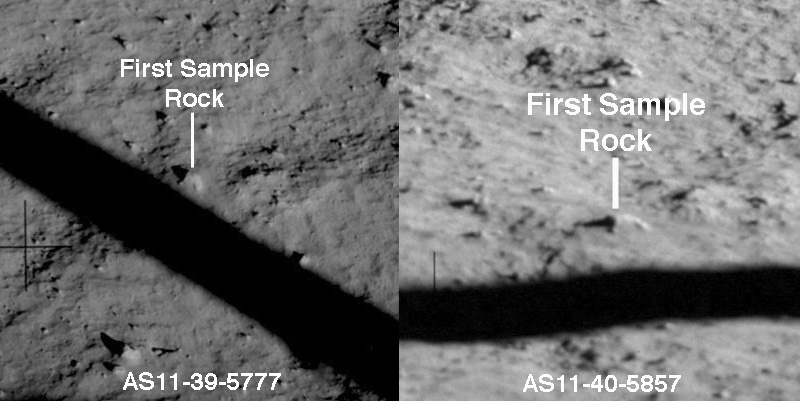
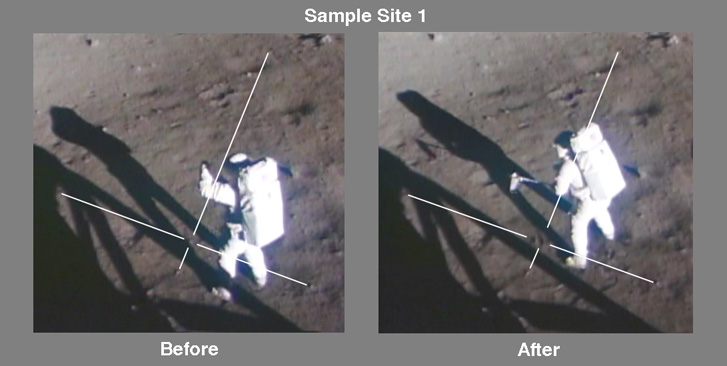
| "Before" and "after" images of Sample Site 1. The white lines, which connect distinctive features - rocks, shadows, etc. - visible in both images, indicate the original location of the Site 1 rock. The scoop mark in the "after" image represents primarily the final motion Neil made with the scoop at Site 1. The video clip (34 Mb) gives details of the multiple scoop motions he made at this location. Click on the image for a larger version. |
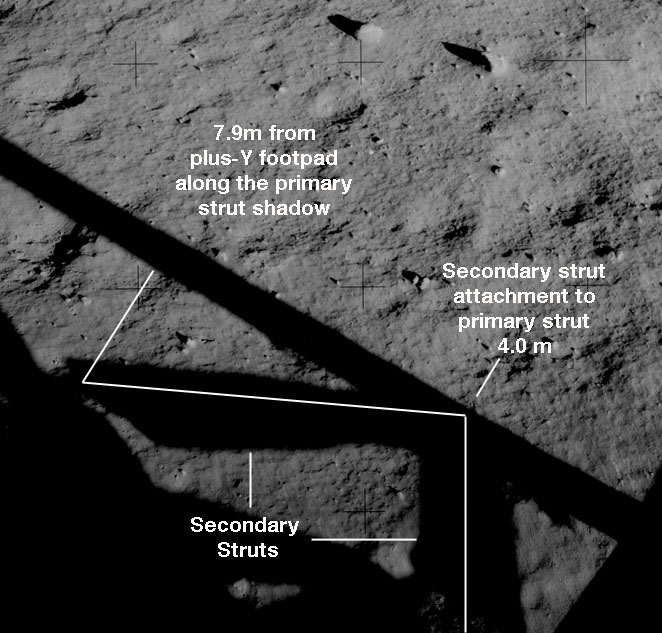

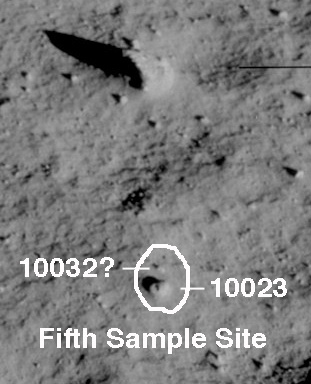
| Detail from AS11-39-5777, taken out Buzz's window before the EVA. See also, a detail from AS11-40-5857, a frame from Neil's ladder pan. |
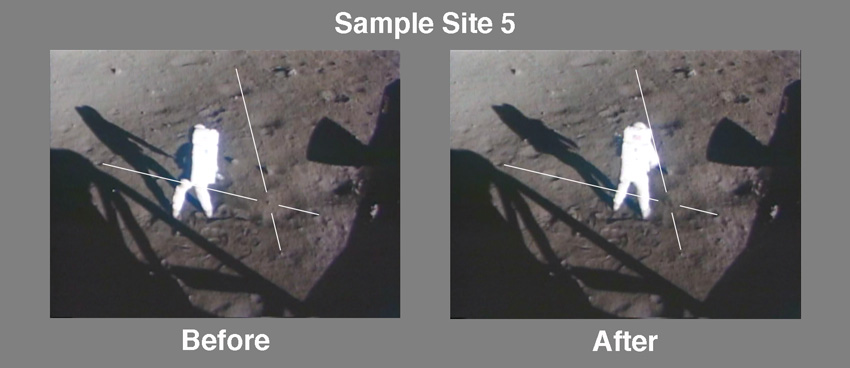
| Journal Home Page | Apollo 11 Journal |